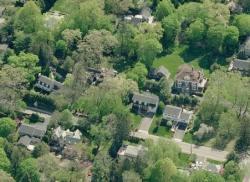The Heathcote School: Progressive Design for Now and Then
- Tuesday, 19 May 2015 14:36
- Last Updated: Tuesday, 19 May 2015 18:29
- Published: Tuesday, 19 May 2015 14:36
- Joanne Wallenstein
- Hits: 17929
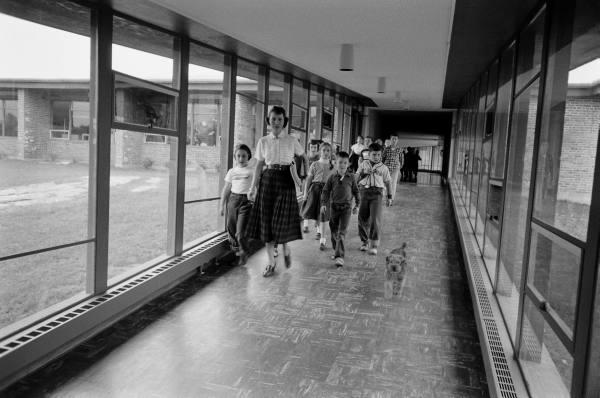 In the days before mid-century architecture became retro, it was considered modern. And when it was built in 1954, the Heathcote School in Scarsdale set the standard for modern school design. Last week, a busload of architects from the firm Perkins + Will, who designed the original school, came to tour this landmark.
In the days before mid-century architecture became retro, it was considered modern. And when it was built in 1954, the Heathcote School in Scarsdale set the standard for modern school design. Last week, a busload of architects from the firm Perkins + Will, who designed the original school, came to tour this landmark.
Designed by Lawrence B. Perkins, the progressive layout included four pods or clusters, rather than perpendicular hallways lined with classrooms. Each pod included classrooms and a central meeting space that could be used for flexible learning. The exterior walls of the school were made with glass rather than brick to bring the outside inside.
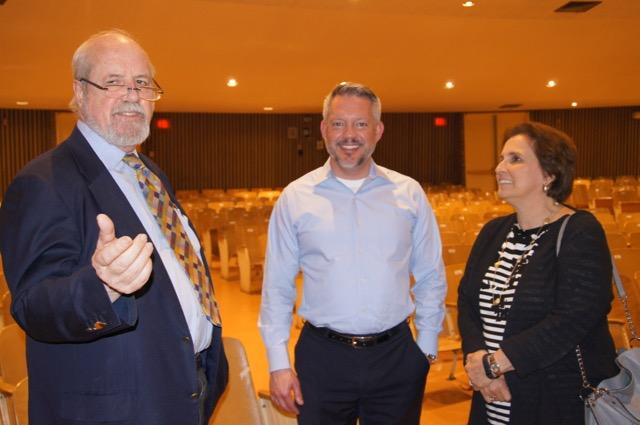 Brad Perkins, a Scarsdale resident who is the son of the architect and an architect himself, greeted the visitors and explained that the Heathcote School was the second innovative school that his father designed. The first was Crow Island, in Winnetka Illinois, another landmark school that coincidentally is the previous home of Scarsdale's new superintendent, Thomas Hagerman.
Brad Perkins, a Scarsdale resident who is the son of the architect and an architect himself, greeted the visitors and explained that the Heathcote School was the second innovative school that his father designed. The first was Crow Island, in Winnetka Illinois, another landmark school that coincidentally is the previous home of Scarsdale's new superintendent, Thomas Hagerman.
Built in 1941, Crow Island shares many features with Heathcote. 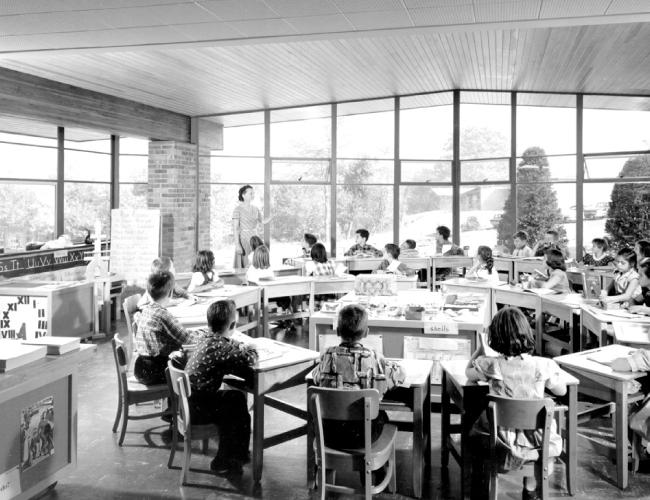 It too was designed by Lawrence B. Perkins – who worked with famed architect Eero Saarinen. Classrooms were grouped in three separate wings according to age and connected by a core of rooms for common use: the auditorium, library, gym, activities room, administration, and so forth. The grounds and play area extending from the classroom wings were also zoned according to age groups to allow for increased freedom and greater safety in play activities. The school won the American Institute of Architects' 25-Year Award, an award that had been given only once before, to the Rockefeller Center in New York City.
It too was designed by Lawrence B. Perkins – who worked with famed architect Eero Saarinen. Classrooms were grouped in three separate wings according to age and connected by a core of rooms for common use: the auditorium, library, gym, activities room, administration, and so forth. The grounds and play area extending from the classroom wings were also zoned according to age groups to allow for increased freedom and greater safety in play activities. The school won the American Institute of Architects' 25-Year Award, an award that had been given only once before, to the Rockefeller Center in New York City.
We had the pleasure of touring the Heathcote School with the architects, and here is what we learned from Joan Blumenfeld of Perkins + Will. The design of the Heathcote School was a departure from traditional school plans. Some of the design elements that were unique and forward-thinking at the time include:
- Classrooms in pods, or clusters, to create smaller subgroups within the school, thus encouraging a greater sense of community for young children.
- Central space in between classrooms that can be used for alternative learning spaces, or for group activities.
- Flexible layouts in the classrooms, allowing the teachers to arrange the furniture differently for different learning activities
- There are no traditional desks facing in a row facing the teacher, for teachers to teach down to the students. The plans encourage interactive learning, allowing for many different kinds of learning activities during the day.
- The idea that learning occurs outside the classroom as well as inside, encouraging physical activity and the engagement with the outdoors. The large windows on all sides of the classrooms, the glass corridors, all make the outside inside relationship stronger.
- Single loading all the corridors, or having them have glass on both sides, allows natural light into them along with views to the outside. There has been lots of research linking better learning outcomes when students have access to daylight and views.
- Using the idea of creating a comfortable environment, such as having a fireplace and little "living room" in the library, so that children can learn in an informal atmosphere.
- Centralizing the shared spaces, such as the auditorium and administration areas, so that they are equidistant from the classrooms. This also allows the classrooms to be at "dead ends" so that there is less traffic in the corridors.
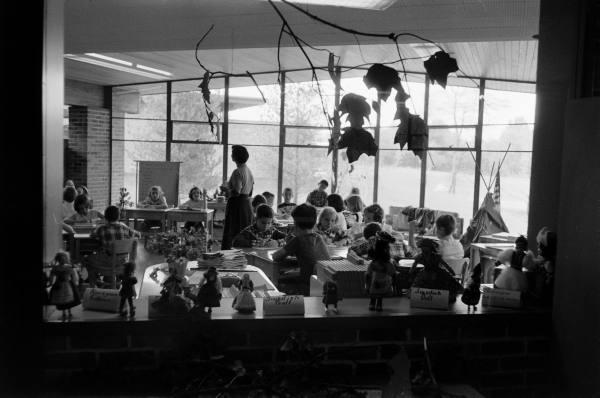 All of these features are emulated in school design today.
All of these features are emulated in school design today.
Some of the features of the school did not stand the test of time. The classrooms were designed for small groups, and there was less "stuff" in them when they were designed, so that they are now a bit cramped, and have inadequate storage space. The lighting and ventilation has been upgraded and the windows have been replaced with more energy efficient models. Technology has been added on, as there was little or none when the school was designed, but as a result it is not well integrated.
We wondered why the school has no cafeteria and were told that at the time Heathcote was built, there was no need for a cafeteria as mothers did not work and children went home for lunch.
Some Scarsdale residents might ask about the relationship between Perkins +Will, the firm that designed the Heathcote School and Perkins Eastman, the firm that designed the new commercial building at the Heathcote Five Corners. Perkins+Will was headed by Larry Perkins and Phil Will when they designed Heathcote School, built in 1953. By the 1980's they had retired and were succeeded by a number of other partners, among them Larry Perkins' son, Brad Perkins. Brad Perkins, along with Mary Jane Eastman, split off from Perkins+Will to form their own firm, eventually named Perkins Eastman, in 1981. The building on Palmer Avenue is by Brad Perkins, along with a local partner.










